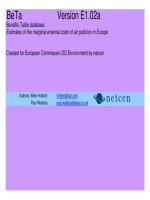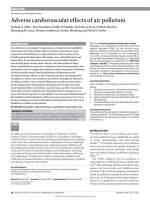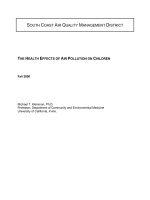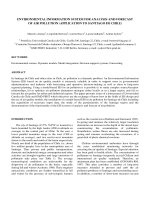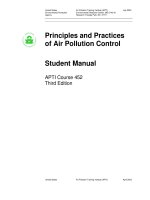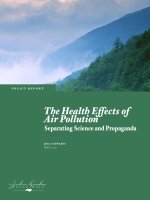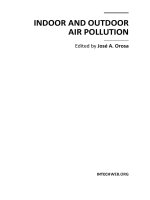Monitoring Control and Effects of Air Pollution Part 1 pptx
Bạn đang xem bản rút gọn của tài liệu. Xem và tải ngay bản đầy đủ của tài liệu tại đây (541.91 KB, 20 trang )
MONITORING, CONTROL
AND EFFECTS OF
AIR POLLUTION
Edited by Andrzej G. Chmielewski
Monitoring, Control and Effects of Air Pollution
Edited by Andrzej G. Chmielewski
Published by InTech
Janeza Trdine 9, 51000 Rijeka, Croatia
Copyright © 2011 InTech
All chapters are Open Access articles distributed under the Creative Commons
Non Commercial Share Alike Attribution 3.0 license, which permits to copy,
distribute, transmit, and adapt the work in any medium, so long as the original
work is properly cited. After this work has been published by InTech, authors
have the right to republish it, in whole or part, in any publication of which they
are the author, and to make other personal use of the work. Any republication,
referencing or personal use of the work must explicitly identify the original source.
Statements and opinions expressed in the chapters are these of the individual contributors
and not necessarily those of the editors or publisher. No responsibility is accepted
for the accuracy of information contained in the published articles. The publisher
assumes no responsibility for any damage or injury to persons or property arising out
of the use of any materials, instructions, methods or ideas contained in the book.
Publishing Process Manager Ivana Lorkovic
Technical Editor Teodora Smiljanic
Cover Designer Jan Hyrat
Image Copyright SimonasP, 2010. Used under license from Shutterstock.com
First published August, 2011
Printed in Croatia
A free online edition of this book is available at www.intechopen.com
Additional hard copies can be obtained from
Monitoring, Control and Effects of Air Pollution, Edited by Andrzej G. Chmielewski
p. cm.
ISBN 978-953-307-526-6
free online editions of InTech
Books and Journals can be found at
www.intechopen.com
Contents
Preface IX
Part 1 Emission and Transformation of Air Pollutants 1
Chapter 1 Generation and Dispersion of Total Suspended
Particulate Matter Due to Mining Activities
in an Indian Opencast Coal Project 3
Ratnesh Trivedi, M. K. Chakraborty and B. K. Tewary
Chapter 2 Secondary Acidification 15
Mizuo Kajino and Hiromasa Ueda
Part 2 Air Pollution Monitoring and Modelling 39
Chapter 3 Gas Sensors for Monitoring Air Pollution 41
Kwang Soo Yoo
Chapter 4 Development of Low-Cost Network
of Sensors for Extensive In-Situ
and Continuous Atmospheric CO2 Monitoring 59
Kuo-Ying Wang, Hui-Chen Chien and Jia-Lin Wang
Chapter 5 Aerosol Optical Thickness and PM10 Study
by Using a Handheld Spectroradiometer Over Penang 73
Tan Fuyi, Lim Hwee San,
Mohd. Zubir Mat Jafri and K. Abdullah
Chapter 6 Remote Sensing of PM2.5 Over Penang Island
from Satellite Measurements 81
Sim Chong Keat, Lim Hwee San,
Khiruddin Abdullah and Mohd. Zubir Mat Jafri
Chapter 7 Photoacoustic Measurements of Black Carbon Light
Absorption/Scattering Coefficients and Visibility
Degradation in Jordan During 2007/2008 93
Khadeejeh M. Hamasha
VI Contents
Chapter 8 PM
2.5
Source Apportionment Applying Material
Balance and Receptor Models in the MAMC 103
V. Mugica, R. Vallesa, J. Aguilar, J. Figueroa and F. Mugica
Part 3 Air Pollution in Office and Public Transport Vehicles 119
Chapter 9 Emission and Formation of Fine Particles from
Hardcopy Devices: the Cause of Indoor Air Pollution 121
David D. Massey and Ajay Taneja
Chapter 10 In-Office Dispersion and Exposure
to Contaminants Originating from an Unfolded Letter 135
Alfred D. Eisner, Russell W. Wiener and Jacky Rosati
Part 4 Effect of Air Pollutants on Historical Objects 151
Chapter 11 Air Pollution and Cultural Heritage: Searching for
“The Relation Between Cause and Effect” 153
Eleni Metaxa
Chapter 12 Effect of Air Pollution
on Archaeological Buildings in Cairo 179
Mohamed Kamal Khallaf
Chapter 13 Influence of Air Pollution on Degradation
of Historic Buildings at the Urban Tropical Atmosphere
of San Francisco de Campeche City, México 201
Javier Reyes, Francisco Corvo, Yolanda Espinosa-Morales,
Brisvey Dzul, Tezozomoc Perez, Cecilia Valdes,
Daniel Aguilar and Patricia Quintana
Part 5 Plasma Technologies for Air Pollution Control 227
Chapter 14 Plasma-Based Depollution of Exhausts:
Principles, State of the Art and Future Prospects 229
Ronny Brandenburg, Hana Barankova, Ladislav Bardos,
Andrzej G. Chmielewski, Miroslaw Dors, Helge Grosch,
Marcin Hołub, Indrek Jõgi, Matti Laan, Jerzy Mizeraczyk,
Andrzej Pawelec and Eugen Stamate
Preface
The municipal and industrial activities of the man affects human health, leads to
degradation of the environment and even degradation of the objects built by himself or
his predecessors. The pollutants are emitted to the atmosphere with off-gases from
industry, power stations, residential heating systems and vehicles, some additional
emissions come from the natural sources as volcanoes as well. Fossil fuels, which include
coal, natural gas, petroleum, shale oil and bitumen are the main source of heat, electrical
energy and are the basic duels for the engines of the transport vehicles. All these fuels
contain beside major constituents (carbon, hydrogen, oxygen) other materials as metal,
sulfur and nitrogen compounds. During the combustion process different pollutants as
fly ash, sulfur oxides ( SO
x = SO2 and SO3), nitrogen oxides (NOx = NO2 + NO) and
volatile organic compounds are emitted. Fly ash contains different trace elements (heavy
metals). Gross emission of pollutants is tremendous all over the world. These pollutants
are present in the atmosphere in such conditions that they can affect man and his
environment. The books addresses the subjects related to the selected aspects of
pollutants emission, monitoring and their effects. The most of recent publications
concentrated on the review of the pollutants emissions from industry, especially power
sector. In this one emissions from opencast mining and transport are addressed as well.
Beside of SO
x and NOx emissions, small particles and other pollutants (e.g. VOC,
ammonia) have adverse effect on environment and human being. The natural emissions
(e.g. from volcanoes) has contribution to the pollutants concentration and atmospheric
chemistry governs speciation of pollutants, as in the case of secondary acidification. The
methods of ambient air pollution monitoring based on modern instrumentation allow
the verification of dispersion models and balancing of mass emissions. The comfort of
everyday human’s activity is influenced by indoor and public transport vehicles interior
air contamination, which is effected even by the professional appliances operation. The
outdoor pollution leads to cultural heritage objects deterioration, the mechanism are
studied and the methods of rehabilitation developed. However to prevent emissions the
new technologies are being developed, the new class of these technologies are plasma
processes, which are briefly reviewed at the final part of the book.
Prof. Andrzej G. Chmielewski
Institute of Nuclear Chemistry and Technology
Warsaw, Poland
Part 1
Emission and Transformation of Air Pollutants
1
Generation and Dispersion of Total Suspended
Particulate Matter Due to Mining Activities
in an Indian Opencast Coal Project
Ratnesh Trivedi, M. K. Chakraborty and B. K. Tewary
Scientists, Central Institute of Mining and Fuel Research,
India
1. Introduction
The knowledge of ambient air quality plays an important role in assessing the
environmental scenario of the region. The ambient air quality status in the vicinity of the
mining activities forms an indispensable part of the Environmental Impact Assessment
Studies. The quality of ambient air depends upon the concentrations of specific
contaminants, the emission sources and meteorological conditions. The mining activities
contribute to the problem of air pollution directly or indirectly (Trichy ,1996, Corti and
Senatore, 2000, Baldauf et al., 2001 and Collins et al., 2001). Coal dust is the major pollutant in
the air of open cast coal mining areas. (Kumar et al., 1994, Vallack and Shillito, 1998. and
CIMFR, 1998) The primary source of fugitive dust at fully operational surface mine may
include overburden (OB) removal, blasting, mineral haulage, mechanical handling
operations, minerals stockpiles and site restoration (Appleton et. al. 2006). Major air
pollutants due to opencast mining are total suspended particulate matter and respirable
particulate matter whereas concentration of SO
2
and NO
X
is negligible (Sinha and Banerjee,
1997, CIMFR, 1998, Banerjee, 2006, and Trivedi et. al., 2009).
Transportation of materials is the major source of TSPM generation in the mining areas. The
vehicle and haul road intersection has been identified as the most critical source producing
as much as 70% of total dust emitted from surface coal mines (Muleski and Cowherd, 1987,
Sinha and Banerjee, 1997, Ghose and Majee, 2002), while it was accounted to be 80-90% of
the PM
10
emission (Cole and Zapert, 1995). Maximal concentrations of particulate matter are
generally occurred during winter and minimal in the rainy season.(Ghose and Majee, 2000,
Tayanc, 2000, Reddy and Ruj, 2003). However, in certain urban areas maximal
concentrations of particulate matters are also observed in summer season (Crabbe et al.,
2000, Almbauer et al., 2001, Triantafyllou et al., 2002 and Triantafyllou, 2003). The dispersion
of particulate matter follows the annual predominant wind direction of an area (Corti and
Senatore, 2000, Baldauf et al., 2001 and Pandey et. al., 2008).
Such a large amount of dust generated cause safety and health hazards such as poor
visibility, failure of mining equipment, increased maintenance cost etc which ultimately
lowers the productivity. A prolonged exposure to air borne dust may cause to damage of
lung tissues of the miners which may further lead to pneumoconiosis or black lung disease.
The maximum tissue damage is caused by the dust of 5 microns lesser sizes since such
particles reach the alveoli of the lung (Peavey et. al, 1985). These air pollutants reduce air
Monitoring, Control and Effects of Air Pollution
4
quality and this ultimately affects people, flora and fauna in and around mining areas
(Crabbe et al., 2000, Wheeler et al., 2000). Implementation of effective air quality control
measures by the mining company are needed and green belts development can be devised
wherever necessary (Kapoor and Gupta, 1984, Sharma and Roy, 1997, Shannigrahi and
Sharma, 2000, Chaulya, 2004).
In the present study, an attempt has been made to generate ambient air quality data, micro-
meteorological data, source-wise emission inventory data for an Indian coal mine namely
Padampur Opencast Coal Project (O.C.P.) of Western Coalfields Ltd. (W.C.L.), India. The
status of TSPM and PM
10
concentration in ambient air has been monitored through a well
defined at monitoring network. In the light of micro-meteorological data such as wind
speed, stability class etc, dispersion coefficients of the dust for vertical as well as horizontal
direction have been estimated. A correlation between TSPM and PM
10
concentration has
been sought out. Emission inventory data for all point, area and line sources of TSPM at
Padampur OCP have been generated for the determination of emission rates. Air Pollution
modeling has also been attempted using Fugitive Dust Model (FDM) developed by United
States Environment protection Agency (USEPA). FDM has been used for the validation of
the study by comparing predicted and observed values. FDM is a computerized Gaussian
Plume Air Quality Model, specifically designed for the estimation of the concentration and
deposition impacts from fugitive dust sources. FDM employs an advance transfer particle
deposition algorithm.(USEPA, 1995). The model gives hourly average, long term
concentration and deposition of particulate matters at all user selected receptor locations.
FDM represents the behavior of particles in the atmosphere most accurately. Since terrain
features are not included in FDM, it can be used only for local scale.
2. Materials and method
2.1 Field settings at OCP
As mentioned earlier that Padampur OCP is selected for the study purpose. Padampur OCP
is located at Chandrapur district in Maharastra State of India. The Project is located between
latitudes 20
0
2’ N to 20
0
3’ N and Longitudes 79
0
17’ E to 79
0
19’ E and is covered by Survey
of India Toposheet No 55 P/8. Geologically the area forms the central part of eastern limb of
Regional anticline structure of Wardha Valley Coalfield of Western Coalfields Limited
(WCL). The area is undulating with few isolated ridges of Kamthi Sandstone. The area
covers two separate and adjoining geological blocks namely Padampur and Motaghat
blocks. The net geological reserve of Padampur OCP is about 43.5 Million Tones. The annual
production is 1 Million Tones with an average stripping ratio of 3.7 m
3
/tones. The coal
produced from the mine is of non-coaking type with ‘D’ and ‘E’ grade. The shovel dumper
combination is being used to excavate the overburden as well as coal. The shovels of 4.6 m
3
bucket capacity and dumpers are of 35 Ton capacities have been deployed in the field.
Backfilling is also practiced simultaneously with the production of coal.
Micrometeorological data collection is an indispensable part of any air pollution study. The
data collected during air quality survey are used for proper interpretation of existing
ambient air quality status. The ambient air quality monitoring was carried out through
reconnaissance followed by air quality surveillance program and micrometeorological study
of the area. A weather monitoring station and SODAR have been installed at study site. The
weather monitoring station measures ambient air temperature in degree centigrade, wind
speed in km. per hour and wind direction in degrees from north. It also measures relative
humidity, barometric pressure, and total rainfall. Site specific relevant parameters like
mixing height and stability class have been accurately measured by SODAR. The amount of
Generation and Dispersion of Total Suspended Particulate
Matter Due to Mining Activities in an Indian Opencast Coal Project
5
turbulence in the ambient air has a major effect upon the rise and dispersion of air pollutant
plumes. The amount of turbulence is categorized into “stability classes”. The most
commonly used categories are the Pasquill stability classes A, B, C, D, E, and F. Class A
denotes the most unstable or most turbulent conditions and Class F denotes the most stable
or least turbulent conditions. The most common procedure for estimating the dispersion
coefficients was introduced by Pasquill (1961), modified by Gifford (1961) and adopted by
the U.S. Public Health Service (Turner, 1970).
Meteorological data has been collected from the nearest Indian Meteorological Department
(IMD) station at Nagpur, India. The climate of the area is tropical. Summer is well defined
from April to June, followed by rainy season from July to September and winter from
December to February. May is the hottest month with temperature rising to a maximum of
around 48
0
C. December is the coldest month when the temperature falls down to about
10
0
C. The mean annual rainfall is around 1250 mm. Wind direction is generally from North
and Northwest, with velocities up to 6-7 Km./hour during monsoon and about 3-4
Km./hour in winter. Relative humidity varies from 74-83% during August and September
and is about 15-20% during summer. Wind rose diagram during the study period is
illustrated in Fig.1.
Fig. 1. Wind Rose Diagram of Padampur OCP
2.2 Ambient air quality monitoring
The ambient air quality status in the impact zone was assessed through a network of ambient
air quality monitoring locations. The studies on air environment include identification of
specific air pollutants for assessing the impacts of proposed mining projects including other
activities. Air quality monitoring was carried out in winter season. Among the ambient air
quality parameters, Total Suspended Particulate Matter (T.S.P.M.) and Respirable Particulate
Matter (PM
10
.) have been measured at 8 hours interval for 24 hours using the High Volume
Sampler with Respiratory Particulate Matter measurement arrangement with the standard
methods as shown in Table 1. Other air qualities parameters are not considered because of
their concentrations are found much below the threshold value in the study area.
The existing status of air environment was assessed through a systematic air quality
surveillance program in which five ambient air quality stations have been selected to know
Monitoring, Control and Effects of Air Pollution
6
the air quality of the area. The measured data of TSPM and PM
10
are shown in Table 2 along
with the arithmetic mean and standard deviation (S.D.) of the measured data.
Para
meter
Time
weighted
Avg.
Concentration
in Ambient
Air
Method Instruments
TSPM Annual
24 hours
430 µg/ m
3
600 µg/ m
3
IS-5182
Part XIV
High Volume Sampler with PM
10
Measurement arrangement (Av. Flow
rate not < 1.1 m
3
/min)
PM
10
Annual
24 hours
215 µg/ m
3
300 µg/ m
3
IS-5182
Part XIV
High Volume Sampler with PM
10
Measurement arrangement (Av. Flow
rate not < 1.1 m
3
/min)
(Source: Central Pollution Control Board Notification, 1994 )
Table 1. Air Pollutant Analysis Methods: Coal Mine Standards
TSPM
(µg/ m
3
)
PM
10
(µg/ m
3
)
Sl.
No.
Sample Site
mean S.D. mean S.D.
PM
10
(Percent
of TSPM
1 Filter Plant 294.30 21.67 120.34 18.90 40.89
2 SAM Office 631.72 58.44 120.03 21.55 19.00
3 Kitadi Village 390.30 32.20 103.03 25.90 26.39
4 Padampur Village 654.38 54.55 130.88 12.15 20.00
5 Manager Office Sec-IV 1078.10 75.56 226.40 35.60 20.99
Table 2. Table Showing Ambient Air Quality of Padmapur OCP
2.3 Source-wise emission inventory details
Emission inventory details have been collected by installing two High Volume Samplers at
down wind sides and, to know the back ground concentration, one High Volume Sampler at
up wind side of the TSPM source. High Volume Samplers are placed at a distance nearly
100m from the source Emission data have been generated for various mining activities such
as overburden loading, coal loading, haul road transportation, unloading of overburden,
unloading of coal, stock yard, exposed overburden dumps, coal handling plant, exposed pit
face and workshop. Blasting being an instantaneous source was monitored separately which
is not included in the present study.
The modified Pasquill and Gifford formula for ground level emission has been used to
calculate the emission rate.
()
Q
,0
Πu σ
y
σz
Cx =
Where, C(x,0) =DN max - UP
C (x, 0), Difference in pollutant concentration , µg/.m; DN max, maximum concentration in
down wind direction; UP, back ground concentration in up wind direction; Q, Pollutant
emission rate, µg/s; Π, 3.14159; u, Mean wind speed, m/s; σy, Standard deviation of
horizontal plume concentration, evaluated in terms of downwind distance x, m (as shown in
Fig. 2); σz, Standard deviation of vertical plumes concentration, evaluated in terms of
downwind distance x, m (as shown in Fig. 3).
Generation and Dispersion of Total Suspended Particulate
Matter Due to Mining Activities in an Indian Opencast Coal Project
7
1
10
100
1000
10000
100 1000 10000 100000
D ownwind D ista nc e from Source
,m
Lateral Diffusion Co-Efficient ,
m
A
B
C
D
E
F
Fig. 2. Lateral Diffusion Co-Efficient Vs Downwind Distance from Source (Source : Turner,
1970).
1
10
100
1000
10000
100000
1000000
100 1000 10000 100000
D ownwind D is tance from Source
,m
Vertical diffusion Co-efficient ,
m
A
B
C
D
E
F
Fig. 3. Vertical diffusion Co-efficient Vs Downwind Distance from Source (Source : Turner,
1970).
Source-wise emission inventory has been shown in Table 3. Source-wise emission properties
such as moisture content silt content etc. measured from the samples collected during field
study have been placed in Table 4. Secondary data affecting TSPM emission such as
frequency of drilling, vehicle movement on the haul road and transport road etc have also
been collected as shown in Table 4.
Monitoring, Control and Effects of Air Pollution
8
TSPM Concentration
(µg/m
3
)
Diffusion
coefficient
Emission Rate
TSPM source
DN
Min
DN
Max
UP
DN
max
-UP
Wind
velocity,
m/s
σy,
m
σz,
m
Unit Value
Drilling 1340 1758 1233 525 2.1 14 8 g/s 0.3877
Overburden
Loading
1234 1660 1108 552 2.4 14 8 g/s 0.4659
Coal Loading 1648 2092 1377 715 2.1 14 8 g/s 0.5218
Haul Road 1963 2498 1336 1162 3.1 14 8 g/ms 0.0127
Transport Road 2015 2605 1387 1218 3.1 14 8 g/ms 0.0132
Overburden
Unloading
1195 1605 942 663 1.9 18 12 g/s 0.8544
Coal Unloading 1438 1897 1135 762 2.0 14 8 g/s 0.5360
Exposed
Overburden
dump
1030 1387 1002 385 2.5 24 16 g/m
2
s 0.0000363
Stockyard 1482 1872 1027 845 1.8 14 8 g/m
2
s 0.0001981
Workshop 1062 1478 1040 438 1.7 25 15 g/m
2
s 0.0000878
Exposed pit
surface
1015 1357 985 372 1.0 15 32 g/m
2
s 0.0000160
Overall mine 469 713 365 348 2.4 95 60 g/m
2
s 0.0000108
Table 3. Source-Wise TSPM Emission Inventory at Padmapur OCP
Emission rate TSPM
sources
Source
type
Moisture
content, %
Silt
content, %
Unit Value
Remarks
Drilling Point 7.4 38.0 g/s 0.443 Hole dia 160 mm;12
hole/day
Overburden
Loading
Point 7.6 13.6 g/s 0.4867 drop height 1.4 m;
frequency 23 no/hr
Coal Loading Point 8.1 10.9 g/s 0.5783 drop height 0.9 m;
frequency 23 no/hr
Haul Road Line 12.4 34.5 g/ms 0.0144 Frequency 18 no/hr;
average speed 2.6m/sec;
Transport
Road
Line 9.8% 30.0 g/ms 0.0146 Frequency 27 no/hr;
Average speed 10 m/sec.
Unloading of
Overburden
Point 7.2 14.2 g/s 1.2740 Frequenc
y
10 no/hr ;drop
height 14.3m.
Unloading of
coal
Point 8.0 11.2 g/s 0.7333 Frequency 7 no/hr; drop
height 2.5 m
Exposed
Overburden
dump
Area 7.4 8.2 g/m
2
s 0.00004 dump area 0.029 sq. km
Stock yard Area 6.0 12.5 g/m
2
s 0.00024 Unloadin
g
freq. 3 No/hr;
loading freq. 12.0 No/hr
Work shop Area 12.4 31.8 g/m
2
s 0.0001 Area 5000 sq. m
Exposed pit Area 8.1 7.8 g/m
2
s 0.00002 Exposed area 0.03 sq.km.
Table 4. Source Wise TSPM Emission Properties
Generation and Dispersion of Total Suspended Particulate
Matter Due to Mining Activities in an Indian Opencast Coal Project
9
3. Results and discussion
Air pollution modeling has been exercised with the help of Fugitive Dust Model (FDM). The
input parameters include source types, dust concentration near sources, hourly
meteorological data such as wind speed and direction, temperature atmospheric stability
and receptor locations. All data depicted the average value for the study period. Emission
source has been demarcated in three categories of sources like point, line and area sources
using mine plan. All these sources have been numbered for preparation of data sheet.
Emission rate has been assigned to each activity as per the field measurement data in the
mine. From the modeling exercise, TSPM concentrations at certain receptor locations have
been predicted. The receptor locations have been selected such that these are exactly same of
one where ambient air quality measurement was carried out. The predicted values at
receptor locations have been added to regional background levels to get the total predicted
TSPM concentration. Regional background data are the average of the monitored data in no
activity zone. The predicted and observed TSPM concentrations at receptor locations for
different mines are listed in Table 5 and Table 6.
Field observations of ambient air quality of Padampur OCP have been placed in the Table 2.
The Ambient Air quality at the five sites of Padmapur is well within the limit except Manager
Office sec IV The higher value of TSPM and PM
10
at Manager Office sec IV may be contributed
by the presence of main transport road and other industries nearby. The 24-hr average of
TSPM concentrations ranged from 294.3 to 1078.1 μg m
−3
in industrial area i.e. mining area and
from 390.3 to 654.38 μg m
−3
in residential area respectively. The 24-hr average of PM
10
concentrations ranged from 120.34 to 226.4 μg m
−3
in industrial area and from 103.03 to 130.88
μg m
−3
in residential area respectively as shown in Table 2. On average the PM
10
in the ambient
air constituted 19.00 % to 40.89 % of the TSPM in mining area and 20.00 % to 26.39 % of the
TSPM in residential area. The concentration of particulate matters vary with the
meteorological parameters and a relation also exist between TSPM and PM
10
(Tayanc, 2000,
Jones et al., 2002, Triantafyllou et al., 2002, Triantafyllou, 2003, Chaulya, 2004). The case under
study also reveals that there exists a relationship between TSPM and PM
10
concentrations.
Linear regression correlation coefficient (R
2
) between TSPM with PM
10
has been found to be
0.8116 as shown in Fig. 4. With the help of FDM, TSPM concentration at five monitoring
stations has been predicted. The variation between measured and predicted values, as shown
in Table 5 and fig. 6 , may be due to non-accountability of emission from various other sources
like non-mining area activities, domestic use of fuels, transportation network nearby thermal
power plant , cement plant etc. The value of coefficient of correlation between observed values
of TSPM Concentration and predicted values by FDM have been calculated to be 0.969
Source-wise emission inventory data placed in Table 3. Stability classes have been found to
be B, C & D. It is clearly evident from the Table 3 that among the point sources namely
drilling, overburden loading, overburden unloading and coal unloading highest value of
emission rates (g/s) has been found in case of unloading of overburden. Among the area
sources namely exposed OB dump, stockyard, workshop, exposed pit surface, highest
values of emission rate (gm/m
2
/s) has been found in case of exposed OB dump. Among the
line sources, emission rates have been in case of haul found and transport road to be 0.0127
gm per meter per second and 0.0132 gm per meter per second respectively. In terms of
overall TSPM pollution line sources contribute more than other sources because of their
lengths and nature of mining operations. This very fact again confirms that the vehicle and
haul road intersection is the major source of dust in opencast mines (Muleski and Cowherd,
1987, Sinha and Banerjee, 1997, Ghose and Majee, 2002) Emission rate for whole mine is
found 0.0000108 gm per sq. meter per second.
Monitoring, Control and Effects of Air Pollution
10
With the help of FDM, TSPM concentration has been predicted at various distances in
down wind direction as shown in Table 6. As far as rate of fall in concentration of TSPM
with the distance from the source is concerned, an exponential fall in the TSPM
concentration with the distance from the source has been observed which can be clearly
seen in the Fig. 5. Maximal concentrations of TSPM and PM
10
have been found to occur
within the mine. Again the dust generated due to mining activities does not contribute to
ambient air quality in surrounding areas beyond 500 meters in normal meteorological
condition as shown in the Table 6. Thus the result matches with the findings of the Several
researchers (Hanna et al., 1982, Chaulya et al., 2001 and Jones et al., 2002, Chaulya, 2004)
that maximal concentrations of TSPM and PM
10
are found in a mining area and the
concentrations are gradually diminished with increase in distance due to transportation,
deposition and dispersion of particles. The value of coefficient of correlation between
observed values of TSPM Concentration and predicted values by FDM have been
calculated to be 0.9957.
From the emission study, it is quite clear that haul road and transport road were the major
contributor to the pollution load of ambient air quality. Therefore proper dust suppression
arrangement is to be made. The prevailing practice of water sprinkling does not seem to be
adequate. Therefore, the installation of continuous atomized spraying system for haul roads
should be used. Exposed overburden dump is another major contributor of pollution load.
These dumps not only contribute to air pollution by way of wind erosion but also spread the
dump it self. Therefore, judicious, plantation on these dumps is highly recommended. These
plantations will not only stabilize the dump but also attenuate the dust emission. Biological
reclamation of overburden dumps and wastelands is also essential. Effective control
measures at the coal handling plant, excavation area and overburden dumps should also be
implemented to mitigate the TSPM emissions at source.
Green belt development around the mining area is highly recommended. The capacity of
plants to reduce air pollution is well known (Kapoor and Gupta, 1984, Sharma and Roy,
1997, Shannigrahi and Sharma, 2000, Chaulya, 2004). A Few plant species can be grown
around highly polluted areas where dust (TSPM) is the main pollutant as given Table 7.
These species not only reduces air pollutants but also retards water and soil pollution.
S. No. Sample site
Observed value
(µg/m
3
)
Predicted value
(µg/m
3
)
1 Filter plant 294.30 250
2 SAM Office 631.72 540
3 Kitadi Village 390.30 325
4 Padmapur Village 654.38 564
5 Manager Office Sec-IV 1078.10 910
Table 5. Comparison between observed and predicted values of TSPM Concentration
Predicted values (µg/m
3
)
TSPM Source
At
source
100 m 200 m 300 m 400 m 500 m
Padampur mine as a whole 698 505 375 260 165 125
Table 6. Predicted values of TSPM Concentration along down Wind Direction

